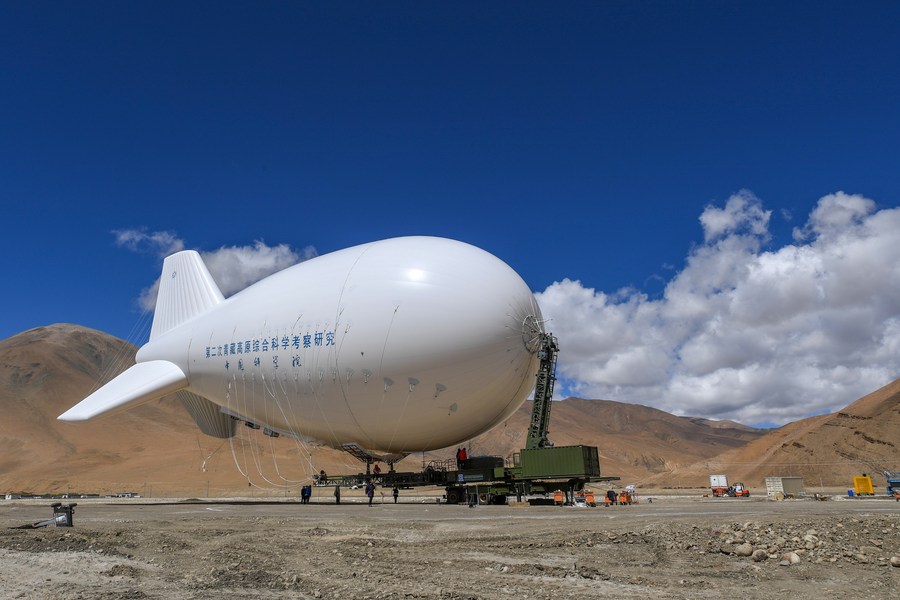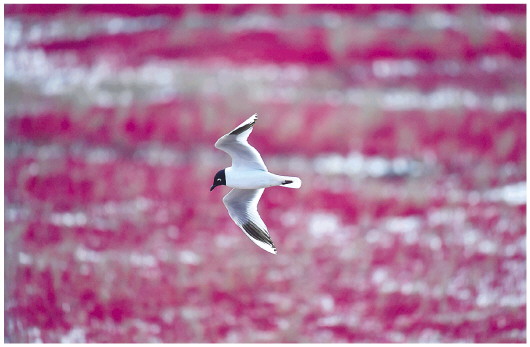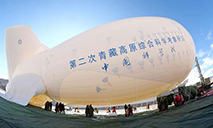China takes Mount Qomolangma scientific expedition to new heights
*On May 4, Dechen Ngodrup, along with 12 scientific expedition team members, reached the summit of the world's highest peak with a height of 8,848.86 meters.
*Dechen Ngodrup's latest endeavor is part of the Chinese comprehensive scientific expedition on Mount Qomolangma, which has involved over 270 scientific researchers in five teams. They are ending their monthlong field investigations, setting several new records in China's history of scientific research on the mountain.
*While mountaineers climbing to the summit of the snow-capped Mount Qomolangma must battle the biting cold and thin air, this epic journey is even harder for scientific researchers as they have to carry 15 kg of equipment and supplies on their backs -- twice the weight carried by ordinary mountaineers -- to complete their investigations.
At the foot of Mount Qomolangma, there is a legend -- Atop the mountain lives a golden bird that lays golden eggs.
Drawn to the tale as a child, Dechen Ngodrup always wanted to climb to the summit of the mysterious mountain known to local Tibetans as "the mother goddess."
On May 4, the 35-year-old Tibetan, along with 12 scientific expedition team members, reached the summit of the world's highest peak with a height of 8,848.86 meters.

Dechen Ngodrup (L) sets up an automatic meteorological monitoring station on Mount Qomolangma on May 4, 2022. (Xinhua/Sonam Dorje)
"I knew there were no golden eggs the very first time I reached the summit," Dechen Ngodrup said with a smile.
For five times he has topped Mount Qomolangma, which straddles the China-Nepal border, with its northern part located in Xigaze of southwest China's Tibet Autonomous Region.
Dechen Ngodrup's latest endeavor is part of the Chinese comprehensive scientific expedition on Mount Qomolangma, which has involved over 270 scientific researchers in five teams. They are ending their monthlong field investigations, setting several new records in China's history of scientific research on the mountain.
NEW RECORDS
In the latest breakthrough, a self-developed floating airship designed for atmosphere observation reached a record altitude of 9,032 meters on May 15, exceeding the height of Mount Qomolangma.

Photo taken on May 12, 2022 shows floating airship "Jimu No.1" type III in Zhaxizom Township of Tingri County, southwest China's Tibet Autonomous Region. (Xinhua/Jiang Fan)
On their way to the summit, the 13-member squad led by Dechen Ngodrup on May 4 established an automatic meteorological monitoring station at an altitude of 8,830 meters, making it the world's highest of its kind. They also measured the thickness of the ice and snow using high-accuracy radar for the first time at the summit.
From May 1 to 8, the glacier and pollutant research team scanned a record area of 22 square kilometers at the east, middle and west Rongbuk glaciers at altitudes between 5,200 meters and 6,500 meters. In the unprecedented survey of the glaciers in the Mount Qomolangma area, they used a drone and a high precision 3D laser scanner.
An Baosheng, deputy head of the Institute of Tibetan Plateau Research under the Chinese Academy of Sciences (CAS) and chief commander of the Mount Qomolangma expedition headquarters, said the deep integration of ultra-high altitude scientific research and mountaineering opens a new chapter for scientific research on the world's highest peak.
China has never stopped exploring Mount Qomolangma. On May 25, 1960, three young Chinese mountaineers climbed to the peak's summit from its more challenging northern slope for the first time in history.
"More than 60 years ago, China couldn't even produce hiking shoes or outdoor jackets. Who could ever think we would set so many records now?" said Ma Weiqiang, head of the CAS Qomolangma station.

Scientific researchers collect water sample at the East Rongbuk glacier near Mount Qomolangma on April 30, 2022. (Xinhua/Dainzin Nyima Choktrul)
Mount Qomolangma is located on the Qinghai-Tibet Plateau, known as "the Roof of the World" and "the Water Tower of Asia." Five years ago, China initiated the second scientific research survey of the Qinghai-Tibet Plateau to reveal the mechanism of environmental change and optimize the ecological security barrier system.
"The climate and environmental changes on the Qinghai-Tibet Plateau have a significant impact on the rest of the world," said Yao Tandong, a CAS academician and team leader of the second scientific research survey of the Qinghai-Tibet Plateau, noting that the ecosystem of Mount Qomolangma, like Earth's landscape in miniature, has its charm for scientists to explore.
With the most disciplines covered, the most scientific research participants, and the most advanced equipment utilized, this expedition on Mount Qomolangma is the largest since the survey of the Qinghai-Tibet Plateau began.
AGAINST ALL ODDS
While mountaineers climbing to the summit of the snow-capped Mount Qomolangma must battle the biting cold and thin air, this epic journey is even harder for scientific researchers as they have to carry 15 kg of equipment and supplies on their backs -- twice the weight carried by ordinary mountaineers -- to complete their investigations.
Dechen Ngodrup said the difficulty of the mission in May was "beyond the imagination."

Members of a Chinese scientific expedition team conduct scientific research on Mount Qomolangma on May 4, 2022. (Xinhua/Sonam Dorje)
His squad spent some eight hours climbing the final 500-meter distance, as they had to walk through snow up to their knees.
"The safety ropes along the route were all buried in the snow. Without the ropes for protection, we could fall at any minute," he said. They had to pull the ropes out of the snow and shake off the ice on the surface before climbing.
The glacier and pollutant research team members took turns dragging the ground-penetrating radar to measure the ice thickness of the glacier, following a zigzag trajectory on the glacier surface. Wang Shaoyong, team member and a doctor from the Northwest Institute of Eco-Environment and Resources (NIEER) under CAS, said his heartbeat reached as high as 160 beats per minute.
"It felt like my heart was going to pop out," said Wang, 29.
The team spent eight days and seven nights on the mountain, including one sleepless night in a tent at an altitude of 6,350 meters. The oxygen level there is less than half that at sea level, and the temperature is lower than minus 10 degrees Celsius at night.

Scientific researchers celebrate when floating airship "Jimu No.1" type III reaches the altitude above 9,000 meters in Zhaxizom Township of Tingri County, southwest China's Tibet Autonomous Region, May 15, 2022. (Xinhua/Tian Jinwen)
Based on the scanned data, the research team will draw a 3D digital elevation map of the glaciers in the Mount Qomolangma area, and then compare it with data collected in the past, including remote sensing data, to establish the trend and pattern of glacier change.
"Through the study of glacier changes and glacier air pollutants, we can see the impact of global and regional human activities on the Qomolangma area," said Kang Shichang, team leader and a researcher at the NIEER.
Piao Shilong, another CAS academician, said that through this expedition, Chinese scientists will unveil more mysteries about the world's highest peak, bringing the world's scientific research on Mount Qomolangma into a new phase.
"There are no golden birds or eggs on top of the mountain. But the scientific data obtained there is even more precious than gold," Dechen Ngodrup said.
Photos
 China’s central bank to issue commemorative coins on cultural theme of auspiciousness, including two heart-shaped coins
China’s central bank to issue commemorative coins on cultural theme of auspiciousness, including two heart-shaped coins Population of endangered black-headed gulls exceeds 10,000 mark in NE China’s coastal city of Panjin
Population of endangered black-headed gulls exceeds 10,000 mark in NE China’s coastal city of Panjin China's self-developed floating airship breaks record
China's self-developed floating airship breaks record Chinese germplasm bank conserves biodiversity in warm temperate zone
Chinese germplasm bank conserves biodiversity in warm temperate zone
Related Stories
- Spanish climber Gines Lopez wins first-ever sport climbing Olympic gold in Tokyo 2020
- In pics: speed finals of UIAA Ice Climbing World Cup
- Highlights of IFSC Climbing World Cup in Tai'an, E China's Shandong
- IFSC Climbing World Cup held in Chongqing, SW China
- Man falls off cliff in Chongqing, survives on dew for 3 days
- Man successfully climbs up 77-meter-high roller coaster
- Moscow “spider-man” climbs Chinese skyscraper
- Climbing fan takes wedding photos on cliff
- National College Climbing Championships kick off in Chengdu
- Ain’t no mountain high enough
Copyright © 2022 People's Daily Online. All Rights Reserved.






